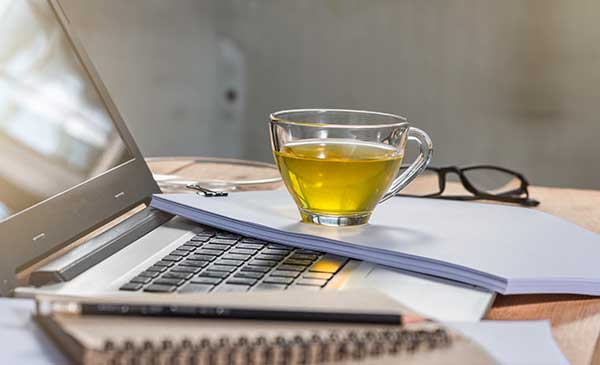A Guide: Learn About Tea

If you already read Our Story, then you know what started my interest in tea. But I found that once I discovered how much I really enjoy drinking tea, then I wanted to explore more tea types.
First off, tea is a very personal experience. The best way to learn about tea is to try several different types. You may not like every tea. But you don't have to be a tea expert to discover a lot about your personal taste buds and how your body reacts to each type of tea.
I have learned a lot along the way, and I want to share with you what I have learned on my tea journey. Because as you are sitting here reading this, you too obviously want to learn about tea. So let's go!
What is Tea?
The term tea is sometimes used very loosely to encompass beverages that aren't actually tea. Tea refers to the leaves that come from the Camellia sinensis plant. This includes Black tea, Green tea, White tea, Oolong, and pu-erh. The difference between these types of tea is in how they are processed.
Black tea is oxidized the most during processing whereas white teas are only allowed to slightly oxidize by exposure to air while drying. This gives white tea leaves a more delicate floral character.
After black tea, the next most oxidized tea is oolong, made of both leaves and stems. Green tea undergoes very minimal oxidation. These are the teas that are most studied for their health benefits.
The higher the level of oxidation, the lower the level of polyphenols.
Tea contains three main compounds: polyphenols, antioxidants, and catechins. The less processed teas (such as white and green tea) retain a similar level of polyphenols to that of the fresh leaf.
The oxidation process transforms the polyphenols into theaflavins and thearubigins which are responsible for the deep, rich flavors such as in black tea and oolong.
Two polyphenols in tea are flavonoids and tannins. Flavonoids, such as EGCG, provide antioxidant power which helps eliminate free radicals, prevent premature aging, and protects against neurological disease. Tannins are what create the flavor profiles in tea.

History of Tea
Tea was discovered in China around 3,000 BC. The exact origin is unknown, but many researchers believe tea originated in the Yunnan province of China. Other research notes the possible existence of the tea plant in Tibet and Northern India. It wasn't until the Tang Dynasty (600-900 A.D.) that tea and the ceremonial aspect became widely popular and tea was declared China's national drink.
Legend has it that the emperor preferred his servants to boil his water before drinking to be sure it was clean. One day when they were traveling in a distant region, they stopped under a tree to rest.
As the servant boiled the emperor's water, a leaf from the tree above fell into the water. Going unnoticed, the servant served it anyway. The emperor found the brownish-colored water to be refreshing, and so tea was born.
The world of tea has grown to be one of the most consumed beverages around the world. Some enjoy it for the cultural experience while others enjoy it on the go in a tea infuser bottle. Hot or iced, tea is now available in a range of flavors from mild and sweet to spicy and bold. The flavors and aromas we savor in each cup make experiencing the health benefits just that much more enjoyable.

The Cultivation of Tea
While most of the tea worldwide comes from China, India, Sri Lanka and Africa, tea is also cultivated in many other countries around the world. Sixty percent of the tea worldwide comes from China and India. India cultivates the most black tea while most green tea is produced in either China or Japan.
Tea plants are grown at elevations from sea level to over 7,000 feet. The plants thrive in cool, wet climates (40 inches a year!) with acidic soil which is responsible for formulating the different flavor profiles. Tea plants grow more slowly at higher elevations giving time for more complex flavors to develop. For this reason, higher elevation teas are considered higher quality.
The tea plant must reach three years of growth before any leaves are harvested. The industry has gone full circle on the method for harvesting—by hand, to machine, and back to hand harvesting. The damage to the leaves from the machinery was too great, lowering the quality of the tea.
Tea plants undergo constant pruning to maintain a manageable height. Pruning also forces growth of new leaves and buds, boosting the yields from each harvest.
Depending on the tea type, the leaves are harvested once to several times annually. The first harvest of the year—the first flush—occurs in spring, with the last occurring in fall. The term "flush" refers to the presentation of new growth on the tea plant.
Once the leaves have been plucked, they are processed to begin the process of withering, oxidizing, and drying depending on the desired type of tea.
What is True Tea?
Calling some teas "true tea" doesn't mean other infusions are "fake tea". The term true teas refers to teas that come from the "true" tea plant, Camellia sinensis. True teas consist of black tea, green tea, white tea, oolong, and pu-erh. Simply by different processing methods, the teas take on completely different characteristics such as flavor, aroma, and visual appearance of the leaf.
During processing, the tea leaf goes through different levels of oxidation, or none at all. Oxidation is when the leaves are exposed to oxygen which causes the leaves to darken – the more oxidation, the darker the leaves. Let's dig a little deeper into what that oxidation process does to each type of tea:
Black Tea
Caffeine content: 14–60 mg
The most processed/most oxidized tea leaf is black tea. During the oxidation process the leaves are allowed to wither, roll, and dry creating the boldest flavor of the true teas. Black tea from China tends to have a stronger flavor than tea from India. The brewed color of black tea will also be the darkest of the teas.
Most black teas come from China, India, Sri Lanka, or Africa. Teas are often named after the growing region, such as Assam (a state in India) and Darjeeling (a city in India). The region also greatly affects the characteristics of the leaf such as form and flavor.
Tea leaves from Sri Lanka can be recognized by their long, wiry form. Assam teas have more of an earthy aroma with a malty flavor while Darjeeling teas have a more floral or fruity flavor. Ceylon teas are fuller-bodied and may have a chocolate flavor.
Oolong
Caffeine content: 30–50 mg
Oolong tea is processed for less time than black tea, and is referred to as semi-oxidized. Oolong is typically oxidized between 8-80%.
After hand harvesting, the leaves are bruised. This is an important step as it breaks down the cells in the leaf allowing the enzymes to begin the oxidation process. Oolong then goes through a similar process to black tea of withering, rolling, and drying. Oolong characteristics fall between black and green tea with a stronger flavor than green tea, but softer than black tea.
Oolong teas are also named after their growing region, which is mostly in China and Taiwan. The terroir (or type of soil, elevation, and climate) plays a big part in the flavor outcome with dramatic differences between oolongs.
The amount of oxidation greatly affects the flavor of the oolong. Oolong tea tends to be medium-bodied with a smooth, floral flavor. The brewed color of oolong tea will range from amber to light green.
Green Tea
Caffeine content: 25–35 mg
The next tea down the oxidation scale is green tea. After being hand-harvested, the leaves are withered to lower the moisture content in the leaves. Once the leaves are withered they are heated to dry the leaves and prevent the oxidation. As the leaves dry, they are carefully shaped by the tea master into shapes such as spindles, pearls, or cakes.
Because green tea undergoes less processing of other types of tea, it contains more antioxidants and polyphenols that are so beneficial to health.
Japan and China are the largest producers of green tea and each have their own unique production methods. Pan-firing is the common method in China that creates an earthy, toasted flavor. Japan predominantly steam dries the leaves creating a more mild, sweet, and vegetal in flavor.
Green tea is more sensitive to steeping time, and can become more astringent if oversteeped. Be sure read how to properly steep green tea. Genmaicha, a special blend of toasted, popped brown rice with tender green tea leaves, reduces the astringency of green tea.
White Tea
Caffeine content: 10–25 mg
The least processed true tea is white tea. Plucking the youngest leaves, white tea leaves are allowed to dry naturally in the sun retaining their natural appearance and flavor. White tea has a delicate sweetness with undertones that can be floral or fruity appealing to both novice and experienced tea drinkers. Honey is often added to promote the sweet flavor.
For higher quality white tea, tea harvesters are more selective on the leaves, such as with Silver Needle which utilizes only the buds of the tea plant.
Due to minimal processing, white and green tea contain the highest level antioxidants. It has been found that white tea releases more antioxidants after extended steeping in hot water, while green tea releases best after steeping in cold water.
Historically, the majority of white teas have been produced in the Fujian province. However, plantations are now found in Africa (referred to as African White) as well as Sri Lanka (called White Ceylon).
Pu-Erh Tea
Caffeine content: 30–40 mg
Another true tea, pu-erh, is categorized as either raw or aged. Raw pu-erh has a similar appearance, flavor and aroma to green tea and has been processed the same way with the prevention of oxidation. However, raw pu-erh is dried in naturally sunshine, while green tea is machine dried.
Aged pu-erh is like a fine wine and has a more robust flavor similar to black tea. The leaves go through a natural oxidation process. Pu-erh leaves are allowed to age typically between 10-15 years, or even up to 50 years for higher quality pu-erh.
Pu-erh is sold either in loose or cake form, but can also be found in pyramids or pearls. When stored properly, the flavor of pu-erh should be fragrant and pure, coating your mouth and throat with a smooth after-taste.
Tisanes/Herbal Tea
Caffeine content: Mostly caffeine-free
Herbal teas (or tisanes are not true teas because they do not come from the Camellia sinensis plant. Rather, tisanes are infusions of herbs, spices, flowers and twigs making almost limitless combinations.
Tisanes have actually been used for thousands of years in traditional medicine.
Herbal teas are blends made from spices, bark, leaves, and flowers of edible non-Camellia sinensis plants. A common mistake is to think that all herbal teas are caffeine-free as well, but not all herbal teas are caffeine free. Some herbal teas come from plants that also provide caffeine such as Yerba Maté which has a significant level of caffeine.
Rooibos
Caffeine content: Naturally caffeine-free
Rooibos is an herbal tea harvested from a shrub (Aspalathus linearis) native to South Africa. Also referred to as African Red Tea or Red Bush tea, rooibos brews into a reddish-brown infusion and is naturally caffeine-free. Rooibos is also void of tannins, so it will not become bitter with over steeping like green or black tea. While not technically a tea, Rooibos is also known to be rich in antioxidants which may provide health benefits.
Flavored Tea
Caffeine content: It depends on the tea in the blend
Flavored teas are like a hybrid, blending true teas with tisanes creating a world of taste profiles. Two examples of a flavored tea are:
-
Raspberry Black tea - black tea blended with natural raspberry flavor, raspberries, and raspberry leaves
-
Chai Green tea - green tea, cinnamon, orange, ginger, cardamom, and cloves.
By blending various spices such as turmeric and ginger, fruits such as blueberries and elderberries, or flowers such as hibiscus, the resulting blend may also provide amazing health benefits.
Conclusion: It's all in the steep
Whatever type of tea you ultimately prefer, make sure you are experiencing all the flavor by using quality tea. While tea bags may seem like the easy answer, you are missing out on experiencing the flavors to their fullest.
Store bought tea bags most often contain broken leaves, dust and fannings left over from production. The lower quality tea has less flavor and lower health benefits. Loose leaf tea provides high quality full leaves that are more beneficial and result in more flavor.
There are several methods for steeping loose leaf tea that can work for your lifestyle. Find the method that works best for you.
Our site has lots of great information on how to make the perfect cup of tea, including steeping techniques, water temperature, how much tea to use, and how to store your tea. Never stop learning!





